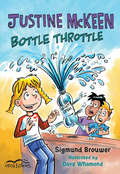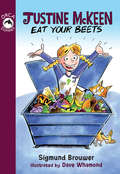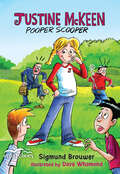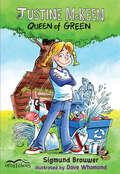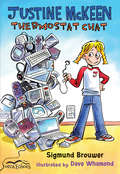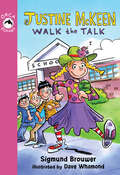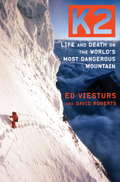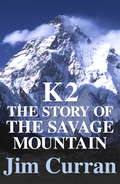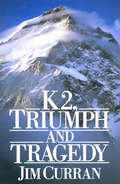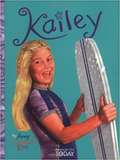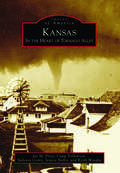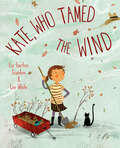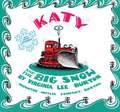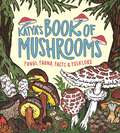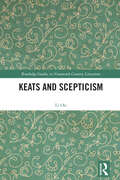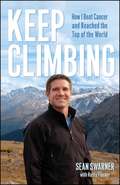- Table View
- List View
Justine McKeen, Bottle Throttle (Orca Echoes)
by Sigmund BrouwerIn this early chapter book, the seventh installment in the Justine McKeen series, Justine sets out to ban bottled water from her school.
Justine McKeen, Eat Your Beets (Orca Echoes)
by Sigmund Brouwer Dave WhamondMeet Justine McKeen, the Queen of Green. She talks a little too much, bosses a little too much and tells the truth, just not all at once. She's trying to save the planet, one person at a time, and when she decides to get something done, it's a lot of fun. In Justine McKeen, Eat Your Beets, the fourth book in the Justine McKeen series, Justine has another brilliant idea to help the planet. When she learns a stray cat and her kittens are living off the food in their school Dumpster, Justine sets out to reduce waste and help save animals in need. Her friends are supportive, but convincing grumpy Mr. Raymond, the cafeteria's manager, to help them put Justine's plan in action is another matter altogether.
Justine McKeen, Pooper Scooper (Orca Echoes)
by Sigmund BrouwerJustine McKeen, the Queen of Green is ready for her third adventure! Justine McKeen talks a little too much, bosses a little too much, and tells the truth, just not all at once. She's trying to save the planet, one person at a time, and when she decides to get something done, it's a lot of fun. In Justine McKeen, Pooper Scooper, the third book in the Justine McKeen series, Justine gets her friends to help her clean up the dog poop in the park across from the school board's offices in an effort to get the attention of the superintendent of schools. She hopes the efforts of her crew of cheerful pooper scoopers will help get the superintendent to see that bringing their school librarian back to work is the right thing to do.
Justine McKeen, Queen of Green (Orca Echoes)
by Sigmund BrouwerJustine's trying to save the planet, one person and one cause at a time. Justine McKeen talks too much, bosses people around too much, and as everyone soon finds out, she tells the truth, but just not all at once. Best of all, when she decides to get something done, it involves a whole lot of laughter and fun for everyone.
Justine McKeen, Thermostat Chat (Orca Echoes)
by Sigmund Brouwer Dave WhamondJustine McKeen is on another mission, this time to rid homes and schools of energy vampires. Justine and her friends, with the help of Principal Proctor, are working to reduce the energy consumption of electronics that suck power from the school when they aren't being used. By cutting down on the miscellaneous electrical load of these electronics, the team is also saving money, reducing greenhouse gas emissions and fighting global warming. Too bad they didn't warn Grandpa Blatzo before they started slaying the vampires! Justine McKeen, Thermostat Chat is part of the Justine McKeen series featuring the Queen of Green.
Justine McKeen, Walk the Talk (Orca Echoes)
by Sigmund BrouwerMeet Justine McKeen. She's the Queen of Green! She talks a little too much, bosses a little too much and tells the truth, just not all at once. She's trying to save the planet, one person at a time, and when she decides to get something done, it's a lot of fun. In Justine McKeen, Walk the Talk, the second book in the Justine McKeen series, Justine decides there are too many cars idling in front of her school. So she comes up with a solution that should help keep the air cleaner. But she soon discovers not many adults trust her crazy ideas.
Justine Mckeen vs. the Queen of Mean (Orca Echoes)
by Sigmund BrouwerJustine McKeen is back, and she’s on a deadline. With only days left before Earth Day, Justine enlists the help of her classmates to count flower buds, frogs, spiders and ants in their natural habitat as part of an environmental science project. But there’s a species right in her own classroom that she’ll have to tackle first--a class bully. Savannah Blue, aka the Queen of Mean, criticizes Justine’s secondhand clothes and calls being green a waste of time. Their teacher, Mrs. Howie, gives the girls a new assignment for Earth Day--they must present together to the class on why it’s important to care for the environment. In the sixth book in this bestselling series, Justine is up against her biggest challenge yet--can she convince the Queen of Mean to go green? The epub edition of this title is fully accessible.
K2: Life and Death on the World's Most Dangerous Mountain
by David Roberts Ed ViestursA thrilling chronicle of the tragedy-ridden history of climbing K2, the world's most difficult and unpredictable mountain, by the bestselling authors of No Shortcuts to the Top. At 28,251 feet, the world's second-tallest mountain, K2 thrusts skyward out of the Karakoram Range of northern Pakistan. Climbers regard it as the ultimate achievement in mountaineering, with good reason. Four times as deadly as Everest, K2 has claimed the lives of seventy-seven climbers since 1954. In August 2008 eleven climbers died in a single thirty-six-hour period on K2-the worst single-event tragedy in the mountain's history and the second-worst in the long chronicle of mountaineering in the Himalaya and Karakoram ranges. Yet summiting K2 remains a cherished goal for climbers from all over the globe. Before he faced the challenge of K2 himself, Ed Viesturs, one of the world's premier high-altitude mountaineers, thought of it as "the holy grail of mountaineering."In K2: Life and Death on the World's Most Dangerous Mountain, Viesturs explores the remarkable history of the mountain and of those who have attempted to conquer it. At the same time he probes K2's most memorable sagas in an attempt to illustrate the lessons learned by confronting the fundamental questions raised by mountaineering-questions of risk, ambition, loyalty to one's teammates, self-sacrifice, and the price of glory. Viesturs knows the mountain firsthand. He and renowned alpinist Scott Fischer climbed it in 1992 and were nearly killed in an avalanche that sent them sliding to almost certain death. Fortunately, Ed managed to get into a self-arrest position with his ice ax and stop both his fall and Scott's. Focusing on seven of the mountain's most dramatic campaigns, from his own troubled ascent to the 2008 tragedy, Viesturs and Roberts crafts an edge-of-your-seat narrative that climbers and armchair travelers alike will find unforgettably compelling. With photographs from Viesturs's personal collection and from historical sources, this is the definitive account of the world's ultimate mountain, and of the lessons that can be gleaned from struggling toward its elusive summit.
K2: The Story Of The Savage Mountain
by Jim CurranK2 is the world's second highest mountain, but its savage reputation is second to none. The loss of Alison Hargreaves and six companions in 1995 was a grim echo of the multiple deaths in 1986 and of earlier disasters which have become part of climbing legend. K2 has always attracted the greatest names in mountaineering. Wiessner, Houston, Bonatti, Diemberger and Bonington are among those whose lives have been permanently scarred by their experiences on it. At the same time some inspiring new routes have been achieved on the world's most difficult 8000-metre peak.Jim Curran, himself a survivor of 1986, has traced the history of the mountain from the nineteenth-century pioneer explorers down to the present, and sees a repeating pattern of naked ambition, rivalry, misjudgement and recrimination. He has also found selfless heroism and impressive route-making on the mountain that top climbers will always covet as the ultimate prize.
K2: The Story Of The Savage Mountain
by Jim CurranK2 is the world's second highest mountain, but its savage reputation is second to none. The loss of Alison Hargreaves and six companions in 1995 was a grim echo of the multiple deaths in 1986 and of earlier disasters which have become part of climbing legend. K2 has always attracted the greatest names in mountaineering. Wiessner, Houston, Bonatti, Diemberger and Bonington are among those whose lives have been permanently scarred by their experiences on it. At the same time some inspiring new routes have been achieved on the world's most difficult 8000-metre peak. Jim Curran, himself a survivor of 1986, has traced the history of the mountain from the nineteenth-century pioneer explorers down to the present, and sees a repeating pattern of naked ambition, rivalry, misjudgement and recrimination. He has also found selfless heroism and impressive route-making on the mountain that top climbers will always covet as the ultimate prize.
K2: Triumph And Tragedy
by Jim CurranK2 is the second highest mountain in the world, at 8611 metres only a couple of hundred metres lower than Everest. It is one of the most unrelenting and testing of the worlds 8000-metre peaks. Jim Curran came to K2 as a climbing cameraman with an unsuccessful British expedition, but stayed on through the climbing season. This is his account of the dramatic events of that summer, a story of ambitions both achieved and thwarted on a mountain which all high-altitude climbers take the most pride in overcoming. In 1986 K2 took its toll of those ambitions. Curran vividly describes the moments that contribute to the exhilaration of climbing on the world's most demanding mountain, and he assesses the tragedy of that summer with compassion and impartiality.
K2: Triumph And Tragedy
by Jim CurranK2 is the second highest mountain in the world, at 8611 metres only a couple of hundred metres lower than Everest. It is one of the most unrelenting and testing of the worlds 8000-metre peaks. Jim Curran came to K2 as a climbing cameraman with an unsuccessful British expedition, but stayed on through the climbing season. This is his account of the dramatic events of that summer, a story of ambitions both achieved and thwarted on a mountain which all high-altitude climbers take the most pride in overcoming. In 1986 K2 took its toll of those ambitions. Curran vividly describes the moments that contribute to the exhilaration of climbing on the world's most demanding mountain, and he assesses the tragedy of that summer with compassion and impartiality.
KULUNDA: South Siberian Agro-steppe as Pioneering Region for Sustainable Land Use (Innovations in Landscape Research)
by Insa Theesfeld Manfred Frühauf Georg Guggenberger Tobias Meinel Sebastian LentzThis book focuses on a representative example and one of the world’s largest steppe conversions, and provides a detailed overview of the results of the BMBF-funded research project KULUNDA. As part of the Siberian virgin land policy, the Kulunda steppe was transformed into agricultural land from 1954 to 1965. In the course of the project, a multidisciplinary research team conducted a natural, social-economic and agro-scientific cause-and-effect analysis of (agro-)ecosystem destabilisation, as well as various field trials covering tillage and crop rotation options in their socio-economic context. The ecologically and economically sound findings offer strategies for combining climate smart land utilization, ecosystem restoration and sustainable regional development, and can readily be applied to other virgin land conversion efforts. In addition, the findings on the Eurasian steppes will expand the current conversion literature, which mainly consists of the ‘Dust Bowl’ literature of the North American plains. Given its scope, the book will appeal to scientists, professionals, and students in the environmental, geo- and climate sciences.
Kabbalah and Ecology
by David Mevorach SeidenbergKabbalah and Ecology is a groundbreaking book that resets the conversation about ecology and the Abrahamic traditions. David Mevorach Seidenberg challenges the anthropocentric reading of the Torah, showing that a radically different orientation to the more-than-human world of nature is not only possible, but that such an orientation also leads to a more accurate interpretation of scripture, rabbinic texts, Maimonides and Kabbalah. Deeply grounded in traditional texts and fluent with the physical sciences, this book proposes not only a new understanding of God's image but also a new direction for restoring religion to its senses and to a more alive relationship with the more-than-human, both with nature and with divinity.
Kailey (American Girl Today)
by Amy Goldman KossWhether she's swimming in the waves or splash-crashin on her surf board, there's no place ten-year-old Kailey loves more than the ocean. She and her best friend, Tess, feel totally lucky when they find out a resort-mall-movie multiplex is "Coming Soon!" to their beach. TWELVE movie theaters. Cool shops. Maybe even bathrooms! Then Kailey learns the whole truth: developers plan to haul away the rocky tide pools to make a smooth, sandy beach for tourists. Messing with a whole tide-pool universe is just plain NOT OK. Kailey's got a great idea, but she's never tried anything like it before. If she can believe in herself and make it work, there might be hope for the tide pools yet.
Kansas City's Parks and Boulevards
by Dona Boley Patrick AlleyA fast-growing frontier community transformed itself into a beautiful urban model of parks and boulevards. In 1893, East Coast newspapers were calling Kansas City "the filthiest in the United States." The drainage of many houses emptied into gullies and cesspools. There was no garbage collection service, and herding livestock through the city was only recently prohibited. Through the diligent efforts of a handful of recently arrived citizens, political, financial, and botanical skills were successfully applied to a nascent parks system. "Squirrel pastures," cliffs and bluffs, ugly ravines, and shanties and slums were turned into a gridiron of green, with chains of parks and boulevards extending in all directions. Wherever the system penetrated well-settled localities, the policy was to provide playgrounds, tennis courts, baseball diamonds, pools, and field houses. By the time the city fathers were finished, Kansas City could boast of 90 miles of boulevards and 2,500 acres of urban parks.
Kansas: In the Heart of Tornado Alley
by Jessica Nellis Craig Torbenson Jay M. Price Sadonia CornsBack in 1915, Snowden D. Flora of the US Weather Bureau wrote, "Kansas has been so commonly considered the tornado state of the country that the term 'Kansas cyclone' has almost become a part of the English language." Flora's words still seem to ring true. Whether called a twister, a tornado, a vortex, or cyclone, these catastrophic events have shaped lives in the Sunflower State for generations. Just a few destructive moments forever changed places such as Irving, Udall, Topeka, Andover, and Greensburg. Even before Dorothy Gale in The Wizard of Oz helped equate the tornado with Kansas, the turbulent nature of local weather seemed to parallel an equally turbulent history, with the fury of people such as John Brown compared to a cyclone. Even if they have never seen a funnel cloud themselves, those who live in Kansas have come to accept the twister as a regular and always unpredictable neighbor.
Kate, Who Tamed The Wind
by Liz Garton ScanlonAward-winning author Liz Garton Scanlon presents a young, rhythmic read-aloud about a girl who solves a windy problem with an environmentally sound solution: planting trees.A wild wind blows on the tippy-top of a steep hill, turning everything upside down for the man who lives there. Luckily, Kate comes up with a plan to tame the wind. With an old wheelbarrow full of young trees, she journeys up the steep hill to add a little green to the man's life, and to protect the house from the howling wind. From award-winning author Liz Garton Scanlon and whimsical illustrator Lee White comes a delightfully simple, lyrical story about the important role trees play in our lives, and caring for the world in which we live.Praise for Bob, Not Bob by Liz Garton Scanlon:"This is read-aloud gold!" --Publishers Weekly, Starred Praise for All the World by Liz Garton Scanlon:"A sumptuous and openhearted poem . . . (that) expresses the philosophy early readers most need to hear: there's humanity everywhere." --The New York Times
Katy and the Big Snow
by Virginia Lee BurtonKaty, a brave and untiring tractor who pushes a bulldozer in the summer and a snowplow in the winter, makes it possible for the townspeople to do their jobs.
Katya's Book of Mushrooms: Fungi, Fauna, Facts & Folklore
by Katya Arnold Sam SwopeMushrooms are exciting to find, beautiful to look at, fascinating to identify, and delicious to eat. When you know what to look for, a mushroom hunt is as safe and enjoyable as a treasure hunt. Katya Arnold ranges through the world to find hundreds of varieties of mushrooms, as well as fascinating anecdotes and fun facts that make these wonders of nature exciting and immediate. A walk in the woods will never be the same!
Kauai Trails
by Kathy MoreyFrom enchanted Hanelei Bay to the rainbows of Waimea Canyon, from Wailua Falls to the sculptured NaPali Coast, Kaua'i has an unmatchable landscape and miles of trails for hikers and backpackers. This new edition details 59 hikes: you'll walk along steep cliffs above turquoise water, relax next to immense waterfalls, drink in the sweet scent of Kaua'i hibiscus, and stroll on beaches at sunrise.
Kaufman Field Guide to Nature of New England
by Kenn Kaufman Kimberly KaufmanWhether you're walking in the woods or along the beach, camping, hiking, canoeing, or just enjoying your own backyard, this book will help identify all your nature discoveries. With authoritative and broad coverage, using nontechnical and lively language, this guide is an essential reference for nature lovers living in or visiting New England.
Keats and Scepticism (Routledge Studies in Nineteenth Century Literature)
by Li OuKeats and Scepticism explores Keats’s affinity with the philosophical tradition of scepticism and reads Keats’s poetry anew in the light of this affinity. It suggests Keats’s links with the origin of scepticism in ancient Greece as recorded in Sextus Empiricus’s Outlines of Scepticism. It also discusses Keats’s connections with Montaigne, the most important Renaissance inheritor of Pyrrhonian scepticism; Voltaire, the Enlightenment philosophe whose sceptical ideas made an indelible impact on Keats; and Hume, the most thoroughgoing sceptic after antiquity. Other than Keats’s affinitive ideas with these sceptical thinkers, this book is particularly interested in Keats’s experiments with the peculiar language, forms, modes, and genres of poetry to convey the non-dogmatic philosophy. In this light, it re-reads Isabella, ‘La Belle Dame sans Merci’, the 1819 odes, the two Hyperions, King Stephen, and Lamia, all of which reveal Keats’s self-reflexive and radical sceptical poetics in challenging poetic dogmas and conventions. This book is for Keats lovers, students, teachers, scholars, or non-academic readers who are interested in Romanticism, nineteenth-century studies, or poetry and philosophy in general. This original, accessible interdisciplinary study aims to offer the reader a fresh perspective to read Keats and appreciate the quintessential Keatsian poetics.
Keats and Scepticism (Routledge Studies in Nineteenth Century Literature)
by Li OuKeats and Scepticism explores Keats’s affinity with the philosophical tradition of scepticism and reads Keats’s poetry anew in the light of this affinity. It suggests Keats’s links with the origin of scepticism in ancient Greece as recorded in Sextus Empiricus’s Outlines of Scepticism. It also discusses Keats’s connections with Montaigne, the most important Renaissance inheritor of Pyrrhonian scepticism; Voltaire, the Enlightenment philosophe whose sceptical ideas made an indelible impact on Keats; and Hume, the most thoroughgoing sceptic after antiquity. Other than Keats’s affinitive ideas with these sceptical thinkers, this book is particularly interested in Keats’s experiments with the peculiar language, forms, modes, and genres of poetry to convey the non-dogmatic philosophy. In this light, it re-reads Isabella, ‘La Belle Dame sans Merci’, the 1819 odes, the two Hyperions, King Stephen, and Lamia, all of which reveal Keats’s self-reflexive and radical sceptical poetics in challenging poetic dogmas and conventions. This book is for Keats lovers, students, teachers, scholars, or non-academic readers who are interested in Romanticism, nineteenth-century studies, or poetry and philosophy in general. This original, accessible interdisciplinary study aims to offer the reader a fresh perspective to read Keats and appreciate the quintessential Keatsian poetics.
Keep Climbing: How I Beat Cancer and Reached the Top of the World
by Sean SwarnerThe 29,035-foot giant known as Mount Everest tortures its challengers with life-threatening conditions such as 100 mph winds, the dramatic loss of oxygen, snowstorms, and deadly avalanches. Climbers of Everest are faced with incredible dangers, but for Sean Swarner the obstacles he overcame prior to his summiting make his story even more compelling. Sean isn't just a cancer survivor; he is truly a medical marvel. He is the only person in the world ever to have been diagnosed with both Hodgkin's disease and Askin's sarcoma. He was diagnosed in the fourth and final stage of Hodgkin's disease at the age of thirteen, when doctors expected him to live for no more than three months. He overcame his illness only to be stricken a second time when a deadly golf ball-sized tumor attacked his right lung. After removal of the Askin's tumor, Sean was expected to live for less than two weeks. A decade later and with only partial use of his lungs, Sean became famous for being the first cancer survivor to climb Mount Everest. Sean's successful summiting of Mount Everest was driven not only by his desire to reach the highest peak in the world but also by his determination to use his accomplishment as a way to bring hope to others facing seemingly insurmountable odds. By showing those affected by cancer how he has conquered some of the most difficult obstacles life could offer, Sean inspires others with the will to live. Living proof that cancer patients can and do recover, his story will encourage those touched by cancer to dream big and never give up. Despite life's setbacks, Sean believes those dreams are always in reach. Sean's story is not just about illness, heartache, and pain; it's about something greater. It's about hope. It's about helping others and never quitting. It's about personal battles with the elements and coming out on top of the world . . . literally.
